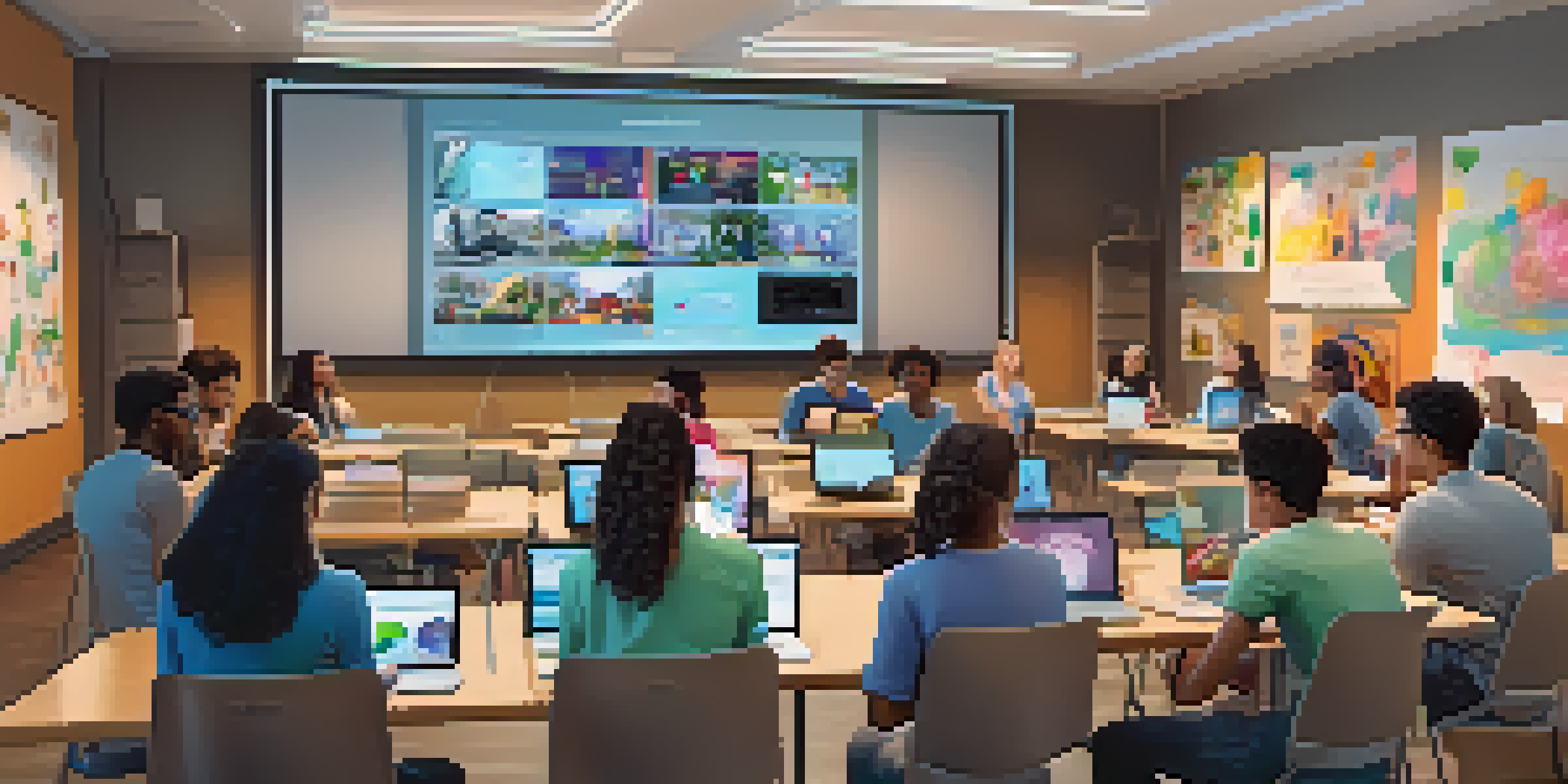AI-Powered Learning Communities: Fostering Peer Support Systems

What Are AI-Powered Learning Communities?
AI-powered learning communities are collaborative networks that leverage artificial intelligence to enhance the learning experience. These communities connect learners, educators, and resources, creating an ecosystem where individuals can share knowledge and support one another. Imagine a classroom where everyone can engage at their own pace, while AI facilitates discussions and resources tailored to each student's needs.
Education is the most powerful weapon which you can use to change the world.
At the heart of these communities is the use of AI algorithms that analyze user interactions and learning habits. This analysis allows for personalized recommendations, helping learners discover relevant content and connect with peers who share similar interests. It's like having a personal tutor and a study group rolled into one, ensuring that no one feels left behind.
Moreover, these communities foster a sense of belonging as they break down geographical barriers. With learners from diverse backgrounds coming together, the exchange of ideas can spark creativity and innovation. This interconnectedness is essential, as it cultivates a supportive environment where individuals feel encouraged to explore and grow.
The Role of AI in Facilitating Peer Support
AI plays a critical role in enhancing peer support by analyzing interactions within the community. By identifying common questions or challenges, AI can facilitate discussions, ensuring that learners get the help they need when they need it. Picture a virtual assistant that not only answers queries but also nudges peers to share their expertise, much like a helpful friend in a study group.

Additionally, AI can match learners with mentors or peers based on their learning styles and goals. This personalized approach encourages collaboration and creates a supportive network, making it easier for individuals to seek help or offer guidance. It’s akin to attending a workshop where everyone can contribute their unique skills and knowledge.
AI Enhances Collaborative Learning
AI-powered learning communities facilitate personalized connections and support among learners, creating an engaging educational ecosystem.
Through these tailored connections, learners can build valuable relationships that extend beyond the digital classroom. This network of support not only enhances academic success but also fosters emotional well-being, as individuals share challenges and celebrate victories together. It's a win-win for everyone involved.
Benefits of AI-Powered Peer Learning Systems
One of the standout benefits of AI-powered peer learning systems is the accessibility they offer. Learners can connect with peers at any time, breaking away from traditional constraints of classroom hours. Imagine being able to ask a question or get feedback late at night when inspiration strikes, thanks to a global network of support.
The art of communication is the language of leadership.
Moreover, these systems can enhance engagement by providing interactive tools that keep learners motivated. Gamification elements, like earning badges for collaboration, can make the learning process more enjoyable and rewarding. It’s like turning education into a game, where everyone wins by participating and helping each other.
Finally, AI-powered peer learning communities contribute to the development of essential soft skills, such as communication and teamwork. As learners collaborate, they gain experience in working with diverse perspectives, which is invaluable in today’s interconnected world. These skills will serve them well, long after they've left the virtual classroom.
Challenges in Implementing AI Learning Communities
Despite the many advantages, implementing AI-powered learning communities is not without its challenges. One major concern is ensuring equitable access to technology, as not all learners may have the same resources or digital literacy. This disparity can create barriers to participation, making it essential for organizations to address these issues proactively.
Another challenge lies in the potential for algorithmic bias, where AI systems may unintentionally favor certain groups or perspectives over others. This can hinder the very inclusivity that these communities aim to promote. Continuous monitoring and improvement of AI systems are crucial to ensure that they serve all learners fairly and effectively.
Accessibility and Engagement Boosted
These systems break traditional barriers, allowing learners to connect anytime and utilize interactive tools to enhance motivation.
Lastly, there is the need for a cultural shift among educators and learners alike to embrace AI as a supportive tool rather than a replacement for traditional teaching methods. Building trust in technology is key, as individuals must feel confident that AI will enhance their learning experience. Open discussions about the role of AI can help mitigate fears and build a collaborative culture.
Best Practices for Building AI Learning Communities
To create successful AI-powered learning communities, organizations should prioritize user-centered design. Engaging learners in the development process can lead to more effective tools that meet their needs. Think of it as co-creating a recipe where everyone contributes their favorite ingredients, resulting in a dish that caters to all tastes.
Additionally, fostering a culture of collaboration is essential. Encouraging participants to share their experiences and insights can help build a sense of community. Regular check-ins and feedback sessions can ensure that everyone feels valued and heard, reinforcing the idea that learning is a shared journey.
Finally, continuous training and support for facilitators and participants alike can enhance the effectiveness of these communities. Providing resources on how to leverage AI tools and fostering digital literacy helps everyone navigate the technology confidently. This support can transform a community from a collection of individuals into a vibrant, interconnected learning hub.
Case Studies: Successful AI Learning Communities
Several organizations have successfully implemented AI-powered learning communities, showcasing the potential of this approach. For instance, platforms like Coursera and EdX use AI to recommend courses and connect learners with peers, resulting in a more personalized learning experience. These platforms highlight how AI can enhance accessibility and engagement in education.
Another great example is the use of AI in corporate training programs, where companies leverage learning communities to foster collaboration among employees. By using AI to match employees with mentors and peers, organizations can create a supportive environment that encourages skill development and innovation. It’s like having an internal network of experts ready to help you grow.
Challenges in Implementation
Despite their benefits, AI learning communities face issues like equitable access to technology and the need for cultural acceptance of AI.
These case studies demonstrate the versatility of AI learning communities across various settings, from academic institutions to corporate environments. As more organizations adopt these models, the insights gained will contribute to the ongoing evolution of peer support systems, paving the way for even more innovative approaches to learning.
The Future of AI-Powered Learning Communities
The future of AI-powered learning communities looks bright, with advancements in technology promising even greater enhancements. As AI continues to evolve, we can expect more sophisticated tools that further personalize the learning experience. Imagine AI systems that not only suggest resources but also adapt to students’ emotional states, providing support when they need it most.
Moreover, the integration of virtual and augmented reality into these communities could create immersive learning experiences. These technologies can facilitate virtual study groups or simulated environments for hands-on learning, making education more engaging and effective. It’s like stepping into a new world where learning is not confined to textbooks but comes alive.

Ultimately, as the landscape of education continues to evolve, AI-powered learning communities will play a crucial role in shaping how we learn and connect with others. By harnessing the power of technology, we can create inclusive, supportive environments that empower learners to thrive. The possibilities are endless, and we're just beginning to scratch the surface.